At a Glance
Summary
Rightangled’s ‘Heart DNA Test’ gave a comprehensive overview of how my genetics could affect my heart health, with plenty of information about the different conditions and what I could do to reduce my likelihood of developing them. For each result I could view the different genes they looked at (though for results looking at several genes, I wasn’t always told my individual genotypes), and I was provided with a list of the research papers they had referenced.
My report also came in a printable PDF format, which condensed some of the information. Both forms included an overall assessment by a healthcare professional, and I was advised to follow up with a doctor if needed.
For those interested in learning more about or improving their heart health, I would recommend this test.
Full Review
Rightangled is a London-based genetic testing company founded by C.E.O. Abdullah Sabyah, a scientist and entrepreneur, and member of the British Heart Foundation Alliance and of the Clinical Pharmacogenomics Implementation Consortium in the US. Sabyah previously invented a technology to detect DNA sequences in real-time.
The company specialises in genetic health testing, and believes that precision medicine used in conjunction with advanced digital tools is the future of healthcare.
Product Expectations
I was to take the ‘Heart DNA Test’, a three-in-one report that would tell me how my genetics affect my predispositions to cardiac conditions, drug responses, and dietary metabolism.
Looking through the information on their website, it seemed that the test would be very comprehensive. They would screen my DNA for genetic predispositions to various cardiac diseases, including Type III Hyperlipoproteinemia, Atrial Fibrillation, Coronary Artery Disease, Hypertension, and others.
In the drug response section, I would learn which medications would be most beneficial to me were I to develop a heart condition or high cholesterol. This also contained responses to oestrogen supplements (such as oral contraceptives), which can cause thrombosis.
The dietary metabolism section would cover the effects of caffeine on my heart, folate metabolism, triglyceride levels, predispositions to HDL and LDL cholesterol, and “Gene X”, which drastically reduces the risk of developing coronary artery disease.
I saw that Rightangled would soon be offering two additional tests: ‘Fitness DNA’, containing training and dietary information, and ‘Wellness Pro’, containing fitness and medical information.
Ordering Experience
Ordering the test online was very simple. I could pay with card, PayPal, or Amazon Pay. I needed to provide an email and shipping address, and delivery was free. I received my kit two days after ordering. I took my sample using a saliva collection tube (there was no blood involved), and mailed it back using the box provided, which was addressed with a pre-paid label.
Before returning my kit, I needed to register online using the code provided. I was required to agree to a disclaimer, and there was also a consent to research form, which was optional.
I had a look through their policies. In the Terms and Conditions, I found they would collect my data (name, IP address, health and genotype information, etc.) for their own market and scientific research. My data would be stored in the European Economic Area (EEA), and may be shared with Rightangled’s subsidiary companies. In the Privacy Policy, I read that they would not share my data with any third party without my expressed consent, unless required to do so by law.
My results would be processed once I had completed an online medical profile. This was comprised of a few health questions, and did not take long to complete. I had to enter my full name, age, gender, ethnicity (from a list), height and weight, smoking status, select whether I had any heart-related health conditions, and enter any information I knew about my cholesterol and blood pressure. I was asked whether I was on any medications, for a comment on my general health, and some lifestyle information. This included questions about how many hours I worked, my work environment, how often I exercise and what kind, my fruits and vegetables intake, and how much water, caffeine and alcohol I drink.
Once I’d returned my kit and completed my medical profile, my results were ready in five weeks.
The Results
I received an email containing a link to my online account. I was prompted to log in, and was then greeted by a written assessment by Dr Ahmed Merghani. At first, I thought this might have been a standard introduction for everyone. But reading it, I realised that it had been personalised for me, and contained references to my results (“You have disclosed that you are currently not taking any medications. The genetic drug responses are therefore largely academic in your case…”).
Having a healthcare specialist look through my results and offer some advice and evaluation made the whole process feel more personal, and the results feel more validated.
My results were broken down into three sections: drug response, inherited conditions, and diet and nutrition (shown below).
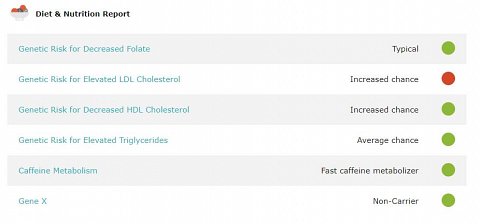
A section from my report containing my diet and nutrition overview.
Results Section: Drug Response
As noted in my introductory letter, the “Drug Response” section was not currently of much use to me, though it might be useful in the future.
I could view my results in a printable PDF, or via my online account. I noticed that there was more information included in my online results vs. the PDF. For the different medications they’d looked at, the PDF contained both my genotype and phenotype results and an “Understand your results” section, while the online results also included the sections “What is it used for?” and “What you can do”. (For the purposes of this review, I explored my results via my online account.)
I found, for example, that I was likely to have a reduced response to beta blockers (shown below).
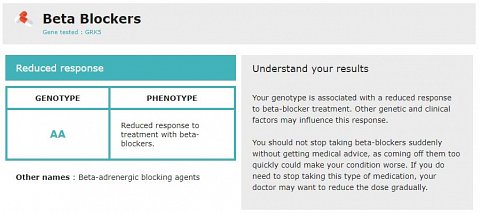
My genetic response to beta blockers.
Since my genotype was AA (meaning I had two copies of the ‘A’ allele), I was likely to have a reduced response to beta blockers. As you can see in the information, I was encouraged not to discontinue use without consulting my doctor if I had already been prescribed beta blockers.
In the “What is it used for?” section, I found that beta blockers are used to treat abnormal heart rhythms, and other heart-related conditions, by lowering blood pressure and blood flow to the heart to reduce stress.
In the “What you can do” section, I discovered that people with asthma aren’t usually advised to take beta blockers, and that I could consult with a healthcare professional about my results.
There was also additional information I could look at, including more information about the drug, the gene(s) they had tested, the clinical significance of beta blockers, and resources (which was a list of research papers).
Looking at the genetic information, I learnt that the gene they had analysed for beta blockers was GRK5, which produces a protein found in the heart as well as other muscles. The ‘T’ variation (which I didn’t have) was associated with enhanced activity of the GRK5 protein and its ability to naturally decrease heart pressure.
Other medications included in the report were warfarin, clopidogrel, oestrogen supplements, simvastatin (which can cause muscle pain and weakness), verapamil, atenolol, metoprolol, and perindopril.
Results Section: Inherited Conditions
In the “Inherited Conditions” section, I found I had an “Increased chance” of developing coronary artery disease and venous thrombosis, and an “Above average chance” of suffering a heart attack (which I took to be a smaller chance than “increased”).
When I looked at the information for coronary artery disease, I was surprised to see that my genotype wasn’t given (shown below).

My genetic likelihood of developing coronary artery disease.
I realised that my genotype wasn’t shown in the table because they had actually looked at a number of genes (which you can see listed in blue in the picture). Curious about what variants I had that had contributed to my risk score, I looked in the “Gene specificity” information. Though they explained what each gene did and what the risk alleles were, I was not given my individual genotype result, meaning that I didn’t know whether I had risk alleles for all, or for only a few of the genes. Since I didn’t know what the average risk of coronary artery disease was, or how much my own risk was increased by, it was hard to tell how at risk of the disease I really was.
In the information, I read that coronary artery disease involved the narrowing of the coronary arteries, which supply the heart with oxygenated blood. This can cause discomfort and damage to the heart, as cholesterol, fat, and other substances build up and prevent the heart from receiving oxygen-rich blood. Symptoms included chest pain, breathlessness, nausea and dizziness. I read that the condition was strongly linked both to genetics and lifestyle.
I could prevent coronary artery disease by eating healthily, maintaining a healthy weight, reducing my salt and alcohol intake, and taking regular exercise. In the resources, I found an embedded video from the British Heart Foundation, which provided further information.
Other inherited conditions listed included type-III hyperlipoproteinemia, atrial fibrillation, myocardial infarction (heart attack), peripheral artery disease, venous thrombosis, hypertension (high blood pressure), and sickle cell anaemia.
Results Section: Diet and Nutrition Report
As had been indicated in my introductory letter, I was at increased risk for elevated levels of LDL cholesterol, and increased risk for decreased HDL cholesterol (shown below).

My genetic risk for decreased HDL cholesterol.
As my result was highlighted in green rather than red, I took this as an indication that the risk wasn’t actually that bad (though my risk for high LDL – “bad” – cholesterol was highlighted in red: an indication that my days were numbered).
In the information boxes, I learnt that good HDL (high-density lipoproteins) cholesterol returned unneeded bad cholesterol from the bloodstream to the liver, where it is either broken down or disposed as waste. I read that individuals over 40 (or younger, if flagged as high risk) should take regular blood tests to monitor cardiac health.
I read that I could maintain good cholesterol by eating healthily, maintaining a healthy weight, taking part in regular exercise, and not smoking. In the information for LDL (bad) cholesterol, I found that I could do pretty much the same things to reduce bad cholesterol, and it was also recommended to reduce fat intake.
Other items in the diet and nutrition section included genetic risk for decreased folate, genetic risk for elevated triglycerides, caffeine metabolism, and “Gene X”, which can reduce the likelihood of developing coronary artery disease by 34%. Unfortunately for me, I wasn’t a carrier.
I wanted to know more about triglycerides, and so I clicked on my result for that. I found I had an average chance of having elevated triglyceride levels (shown below).

My genetic risk for elevated triglyceride levels.
In the information, I discovered that triglycerides are a type of fat we can get from our diet. People who are obese, who smoke, or are heavy drinkers of alcohol, are more at risk of elevated triglycerides, which increases the chance of heart disease. Since all my other genetic markers indicated I would have to take care to avoid high cholesterol and coronary artery disease, I was glad that I wasn’t at risk of high triglyceride levels too!
As with cholesterol, I read that regular exercise, healthy eating, not smoking, drinking less alcohol, and maintaining a healthy weight would all help to reduce triglyceride levels.
I was curious about my caffeine metabolism result, and wasn’t surprised to see that I was a fast caffeine metaboliser, since I’ve never noticed any real difference to my heart rate or energy levels from drinking caffeine!
Summary
Rightangled’s ‘Heart DNA Test’ gave a comprehensive overview of how my genetics could affect my heart health, with plenty of information about the different conditions and what I could do to reduce my likelihood of developing them. For each result I could view the different genes they looked at (though for results looking at several genes, I wasn’t always told my individual genotypes), and I was provided with a list of the research papers they had referenced.
My report also came in a printable PDF format, which condensed some of the information. Both forms included an overall assessment by a healthcare professional, and I was advised to follow up with a doctor if needed.
For those interested in learning more about or improving their heart health, I would recommend this test.
(Please note we were invited to take this test free of charge.)
See a description of this DNA test from Rightangled Diagnostics >
At a Glance
Summary
Overall, I found that the ‘Full Heart DNA Test’ gave a meticulously detailed insight into the genetics related to my heart health and the science behind the results. While the text-heavy format was a little difficult to process at times, I was grateful for the Summary Report, which condensed a lot of the information into a more digestible format and helped me navigate the rest of the reports.
I also appreciated the fact that I was often directed to a plentiful range of resources based on my results, as well as the opportunity to follow up with a practitioner if that wasn't enough. I was very pleased with the process and would recommend this test to those interested in finding out more and improving their heart health.
Full Review
Rightangled Diagnostics is a British DNA testing company that was founded in 2016. They specialise in promoting heart health and helping customers find targeted treatments using genetic testing. By examining the DNA of their customers, Rightangled Diagnostics hope to personalise healthcare, specifically by reducing the trial and error often involved in the prevention and treatment of heart disease.
The company was founded and continues to be led by Abdullah Sabyah, a scientist-entrepreneur and a healthcare professional. In addition to running Rightangled Diagnostics he is a member of the British Heart Foundation Alliance, and the inventor of patent-pending scientific technology. With an impressive range of achievements in the field, I was excited to see how Rightangled would put this specialist knowledge to use.
Product Expectations
The Rightangled Diagnostics website was really nicely laid out and easy to navigate. I quickly found out that they offered three different DNA tests that looked at 'Diet and Nutrition', 'Drug Response' and 'Inherited Conditions', plus a bundle package of all three.
There were product descriptions provided for each test, which gave a full list of the genetic traits would be covered in the report, and a bit of explanatory information about each. I was impressed that these descriptions also included the genes that would be analysed and a list of references to the scientific papers that had been used to choose them.
I learned that the Diet and Nutrition report would help me understand my body's response to certain nutrients, and how I could tailor my lifestyle and diet to reduce the chance of developing cardiovascular diseases.
I read that the Drug Response report was designed to help my doctor direct my course of treatment, by identifying the drugs that would benefit me the most. Although the test was targeted at those following or about to follow treatment related to heart disease, I thought that it would be useful to have this information for future reference.
The Inherited Conditions test promised a personalised report listing genetic predispositions that might affect my cardiovascular health. All the results would be reviewed and assessed by partner specialists, taking into account my genetics and lifestyle information. Although I was a little nervous about finding out if I was predisposed to any heart conditions, I felt I was in safe hands with all of the specialist knowledge Rightangled Diagnostics had access to.
Ordering Experience
I chose to order all three options with the 'Full Heart DNA Test' and was given the choice to pay with a debit or credit card, after accepting the terms and conditions. I was pleased to see that these included some quite rigorous data protection policies, including that the company would stop processing and delete my personal data at any time, if I requested that they do so.
I received the kit a few days after ordering, which included clear directions for registration and using the saliva collection tube. As part of the registration process, I was prompted to fill out a brief questionnaire with details about my health and lifestyle. This was pretty straightforward and it took less than 10 minutes to take the sample and complete the questions. I was able to use the box that I had received to return my sample to the lab for free.
The Results
Unfortunately, I received the results a few weeks later than expected. However, when I emailed customer services, to see when they would be ready, they were very helpful and responded the same day.
Soon afterwards, I received an email with the three reports as PDF files, plus a fourth Summary Report PDF. Each document ranged from 11 to 45 pages, and was password protected with my kit number.
Results Section: Summary Report
I started by looking through my Summary Report. This began with a few pages of forms, containing all the medical information I had provided, as a 'Health Profile' and 'Lifestyle Profile'. I was pleased to see the report was signed off by a doctor, whose details were provided. All of the most significant results from my three reports were clearly laid out in tables. The one for my 'Coronary artery disease' result is shown below.
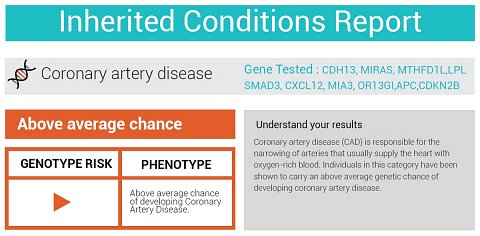
A Section of my Summary.
I wasn't sure what ‘Genotype Risk’ or 'Phenotype' meant, but the result itself was clear. I also found that a section called 'Understanding your results' was helpful in explaining a bit about what it might mean for my heart health. I noticed that in the Genotype Risk column there was a triangle, but other results showed letters. I wasn’t sure what this indicated and couldn’t find anything explaining it in the report.
I was concerned to see that I have an above average genetic chance of developing coronary artery disease, though it wasn’t a particular surprise as I have a family history of heart issues. In addition, I found out that I’m more likely than average to suffer from hypertension, which the report explained meant high blood pressure. I've never had any problems with my blood pressure, but will now make sure to keep a close eye on it as I age. Overall, the Summary Report gave me a good idea of which particular results to focus on when going through the rest of my reports, especially in terms of any advice that might be provided.
Results Section: Diet and Nutrition
The Diet and Nutrition report was the shortest of the four, and its table of contents named only three sections, 'Caffeine Metabolism', 'Folates' and 'Disclaimer'. I had seen the long list of traits analysed in this report on the website, so assumed that all the genetic traits which were omitted from the report were the ones that gave no significant results. Although I couldn’t be sure that this was the reason, I appreciated this format, having seen some of the longer, more text-heavy documents.
I found out that I was likely to break down caffeine more slowly than average, which meant I was at higher risk of a non-fatal cardiac event. The table (shown below) also listed sections for 'Other names' (in this case, coffee) 'What is it?' and 'What you can do about it'. These sections put my results into the context of everyday life, which made them easier to understand. I found out that caffeine was a natural drug which increases the heartrate, and was surprised to read that it could be found in chocolate as well as tea and coffee.

Part of my results table for Caffeine metabolism.
The following 'Go in-depth' section of the report spent two pages detailing three sections. 'About the Nutrient' told me where caffeine could be found and how it works, 'Genetics' explained a bit about the science behind my reaction to it. I discovered that the genetic variant I carry means that the molecules in my body that break down caffeine have lower levels of activity than average. The third section was 'Clinical significance' which specified some of the side effects and treatments for conditions pertaining to this result.
Although, at times, I was a bit thrown by the frequent use of unfamiliar phrases like 'purine alkaloid', I found that in general, the scientific terms were given some explanation. This said, I have to admit that I found myself tempted to skim some of the text, as it was quite dry.
I found the tips in the 'What you can do about it' section for Folates a bit more detailed than for caffeine, (which told me to cut down on food and drinks containing caffeine.) Here I was recommended specific fruits and vegetables such as oranges and asparagus to prevent folate deficiency. There was a lot of in-depth description of the tests and explanation of scientific terms. I was a little surprised that in such a long document, the practical and actionable advice boiled down to a couple of lines for each result.
The clinical significance section of my folate results explained that folate deficiency manifested in symptoms including a loss of appetite, weight loss, weakness, headaches, palpitations. This section also told me that the condition was sometimes treated by injection, which was certainly a motivator to keep an eye out for any of the symptoms they had flagged up, and get hold of some orange juice to keep my folates in check.
Results Section: Drug Response
Next, I moved on to my Drug Response report and was, at first, a little overwhelmed at the length of the document. However, a table of contents provided a useful way to navigate the report and find specific results. Whilst the number of references in the report made it slightly difficult to read, at times, I was glad to see such transparency around the scientific process and evidence. I also found it useful that the more significant results were in red or orange while the less urgent results were in green.
As I don't take any heart medication, and am not expecting to any time soon, this section of the report didn’t immediately seem to be that useful to me. However, I learnt, in the ‘Estrogen Supplementation’ result, that I wasn’t genetically predisposed to thrombosis (blood clotting), as a side effect of the contraceptive pill I take. Moreover, it was good to know that if anything were to develop in the future, I would be able to refer back to this.
For each listed drug, a table showed what my likely response would be with regards to my heart health, as shown below for my Estrogen Supplementation result.
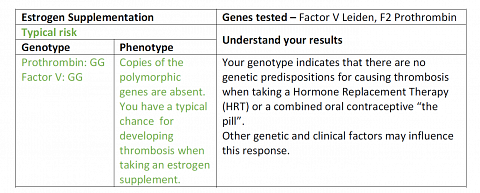
Part of my Drug Response Result for Oestrogen Supplementation.
There was also some potentially useful information about drug interactions and side effects. For example, one table gave me a side by side comparison of two drugs, Verapimil vs Atenolol. Both are used to treat heart diseases and high blood pressure and I was informed both drugs would be likely to give me the same benefits. This meant that any side effects from one drug might be removed by switching to the other, as it was likely to be just as effective.
I also found out that I was likely to have a reduced response to beta blockers, which are drugs used to treat a lot of heart conditions. I learnt that they work by lowering blood pressure and blood flow to the heart, reducing stress and pressure on it and preventing further damage. It was also good to know that beta blockers often disguise the early symptoms of diabetes - which I had found out I was genetically predisposed to in a previous DNA test. I now know to be aware of this if I ever have to take beta blockers.
The advice was accompanied by a warning that I should 'consult with a healthcare provider about confirming its influence on your health', and, in many places, I was asked to consider any family members' conditions when going through the result and advice. There were numerous disclaimers throughout the report, telling me to consult my doctor before I made any decisions, and although they were a little repetitive, this made a lot of sense.
After each table, there was the same breakdown of the result as the Diet and Nutrition report, with a detailed description of the drug and how it worked, the gene analysed and the clinical significance of the result. This included a list of side-effects and possible interactions with other drugs. Although the amount of information was a little daunting, I found some genuinely useful advice, including some preventative measures for diseases I might be more likely to develop. This included things like lowering intake of cholesterol and saturated fat, getting regular exercise and lowering alcohol intake. I was also recommended some resources such as 'Medicines for your Heart - British Heart Foundation Booklet 2017'. Unfortunately the 'Download here' hyperlink wasn't working.
Results Section: Inherited Conditions Test
Finally, I looked at my Inherited Conditions report. This included information about eight conditions: type 3 hyperlipoproteinaemia (type 3 HLP), atrial fibrillation, coronary artery diseases, myocardial infarction, peripheral arterial disease, venous thrombosis, hypertension and sickle cell anaemia. Having read in my Summary Report that I’m at an above average risk of developing coronary artery disease, myocardial infarction and hypertension, this was the report I was most interested to see. I was pleased that it included a detailed description of every condition which had been tested for.
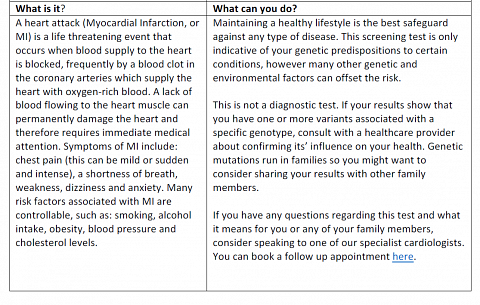
A Section of a Table from my Inherited Conditions Test Report.
The advice in the 'What can you do?' section of my myocardial infarction result was 'maintaining a healthy lifestyle is the best safeguard against any type of disease', followed by a disclaimer about the result's applicability. I found in the clinical significance section gave a bit more of an explanation for the suggested healthy lifestyle, which meant eating healthily, maintaining a healthy weight, appropriately managing stress, getting regular exercise, quitting smoking (which luckily, as a non-smoker I don’t need to do!) and reducing alcohol intake. I was glad to have some practical and actionable advice for reducing the risk.

Resources offered in the Clinical significance section of my result for Myocardial infarction.
I was surprised to see a YouTube link in the table of results for hypertension, which I had an above average risk of developing. The video I was directed to was from the British Heart Foundation, and one woman gave her story of how she combatted high blood pressure. There was some useful advice about diet and exercise. Throughout the report, I was directed to many resources from the British Heart Foundation, and although these are readily available to the public, it was really helpful to have all their resources filtered through the priorities of my personalised report.
Summary
Overall, I found that the ‘Full Heart DNA Test’ gave a meticulously detailed insight into the genetics related to my heart health and the science behind the results. While the text-heavy format was a little difficult to process at times, I was grateful for the Summary Report, which condensed a lot of the information into a more digestible format and helped me navigate the rest of the reports.
I also appreciated the fact that I was often directed to a plentiful range of resources based on my results, as well as the opportunity to follow up with a practitioner if that wasn't enough. I was very pleased with the process and would recommend this test to those interested in finding out more and improving their heart health.
Please note that we were invited to take this test for free
See a description of this DNA test from Rightangled Diagnostics >


